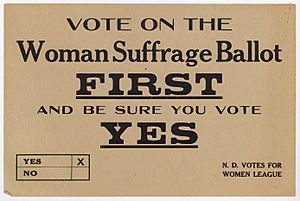Timeline of women's suffrage in North Dakota facts for kids
This is a timeline of women's right to vote in North Dakota. The journey for women to gain voting rights in North Dakota started when it was still known as the Dakota Territory. In 1879, women in the territory were first allowed to vote in school meetings. This right became more official in 1883, giving women special voting slips just for school-related issues.
After North Dakota became a state, people who supported women's voting rights, called suffragists, kept working for full voting equality. A public vote, called a referendum, was held in 1914 to decide on equal voting rights, but it did not pass. However, in 1917, women won the right to vote in local city elections and for president. Finally, on December 1, 1919, North Dakota became the 20th state to officially approve the Nineteenth Amendment. This important change to the U.S. Constitution gave women across the country the right to vote.
The 1800s: Early Steps for Voting Rights
1860s: First Ideas
1868
- Enos Stutsman suggests a bill (a proposed law) to allow women to vote in the Dakota Territory's government.
1870s: School Voting Begins
1872
- The government of the Dakota Territory almost passes a bill for full women's voting rights. It loses by just one vote.
1879
- The Dakota Territory gives women the right to vote in meetings about schools.
1880s: More Changes and Challenges
1883
- A new rule makes women use separate voting slips for school issues. This made it harder for some women to vote.
1885
- John Pickler proposes a bill for women's voting rights in the Territorial House. It passes, but Governor Gilbert A. Pierce says no to it (he vetoes it).
1887
- A bill passes that expands women's right to vote for all kinds of school issues.
- Another bill for full women's voting rights is suggested, but it does not pass.
1888
- People in Grand Forks ask for a women's voting rights group to be formed. A meeting on April 12 to create the group is very popular.
1889
- After the Dakota Territory becomes two separate states, North Dakota and South Dakota, two different groups working for women's voting rights are formed.
1890s: State Conventions and Efforts
1890
- August 4: In a special election, Sara E. B. Smith and Cora Smith Eaton cast their votes, and their votes are counted as valid.
1893
- March 3: Elizabeth Preston Anderson speaks to the state legislature.
- A bill is suggested to allow all taxpayers to vote, but it does not pass.
1895
- November 14–15: The first statewide meeting for women's voting rights is held in Grand Forks.
- A bill for women's voting rights is suggested in the state legislature, but it does not pass.
1897
- November 30: The second statewide women's voting rights meeting is held in Fargo.
1898
- September 27–28: The third statewide women's voting rights meeting is held in Larimore.
1899
- September 26–27: The fourth statewide women's voting rights meeting is held in Hillsboro.
The 1900s: Gaining Full Voting Rights
1900s: Continued Meetings
1900
- September 25–26: The fifth statewide meeting for voting rights is held in Lakota.
1901
- July 17: The Equal Suffrage Association of North Dakota holds its yearly meeting in Devil's Lake.
1910s: Big Steps Forward
1912
- February 4: Sylvia Pankhurst, a famous British suffragist, meets with North Dakota suffragists at Mary Darrow Weible's home.
- June 13: A statewide "Votes for Women League" is created.
1913
- An amendment (a change) to the state constitution, called the Cashel suffrage bill, passes in the state legislature. It needs to pass again in the next session to become law.
- October 18: The first "Votes for Women" meeting is held in Fargo.
1914
- The Woman Suffrage League of Bismarck is formed.
- The North Dakota Association Opposed to Woman Suffrage (a group against women voting) is created in Fargo.
- November 4: A vote on the women's suffrage bill takes place. It does not pass.
1915
- The Cashel suffrage bill does not pass a second time, so it fails.
- June: A statewide women's voting rights meeting is held in Valley City.
- October 10: A statewide women's voting rights meeting is held in Minot.
1916
- October 13: A statewide women's voting rights meeting is held in Valley City.
1917
- January 14: Senator Oscar Lindstrom introduces a bill to allow women to vote for president and in city elections. A bill for a constitutional amendment for full voting rights for women in North Dakota is also introduced. Both bills pass.
- January 23: Governor Lynn Frazier signs the bill for presidential and city voting rights into law. He also signs the law about the amendment to the state constitution.
- September 25–26: A statewide women's voting rights meeting is held in Bismarck.
1919
- December 1: North Dakota becomes the 20th state to officially approve the Nineteenth Amendment, giving women the right to vote nationwide.
1920s: Full Voting Rights for Many
1920
- November: Most women in North Dakota are now able to fully use their right to vote.
1924
- The Indian Citizenship Act is passed. This law should allow Native American women to vote.
1950s: Removing Old Rules
1958
- The state constitution no longer has a rule that only allowed Native Americans to vote if they gave up their tribal connection two years before an election.




